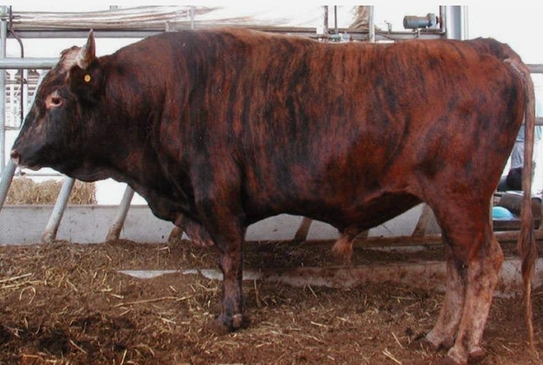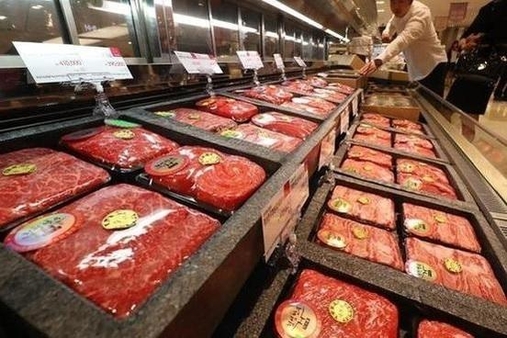Input 2021.01.01 12:09
–
At the end of last year, Kim Myung-sik’s Korean cattle, who runs a Korean cattle farm in Gyenam-myeon, Jangsu-gun, Jeollabuk-do, gave birth to three twins, including one bull and two female calves. Less than 5% of cows give birth to twins, and less than 0.1% of triplets are a miracle.
Cows have been treated as precious as people thanks to their outstanding workforce since the Samhan Period, when agricultural culture began to settle on the Korean Peninsula. It is rich in protein and a variety of nutrients, but when plowing the paddy fields, it easily replaced dozens of longevity. Because of this excellent workforce, the state even prevented the country from grabbing cattle.
Now, thanks to the mechanization of agriculture, farmers who raise cattle to secure labor as in the past have virtually disappeared. In fact, no farmers have the skills to deal with the sweep. However, the number of Korean cattle breeding has not decreased. This is because Korean beef consumption is steadily increasing thanks to the excellent nutrients and taste of Korean beef. As of the end of October last year, the number of domestic beef breeding heads exceeded 3.2 million for the first time ever.
◆Is all Korean beef bull?
Currently, there are five varieties of Korean cattle listed in the Food and Agriculture Organization of the United Nations: Hwangwoo (yellow cattle), black cattle (black cattle), Jeju black cattle, arrowroot (leopskin) and white cattle (white cattle).
There are disagreements about when Korean cattle existed. However, it is possible to infer that it existed on the Korean peninsula for at least 2,000 years ago when you saw paintings and stories of cows appearing in ruins such as the Three Kingdoms, Wiji Dongijeon, Goguryeo Muyongchong (Anak No. 3 tomb), and Gimhae Shell Mound.
The Korean beef that most Koreans think of is Yellow Cow, or Bull. However, on the Korean peninsula there were not only Yellow Cows but also cows of various colors. In Ugyeong-do, a genre painting by Shin Yun-bok and Kim Hong-do during the Joseon Dynasty, you can see cows with various fur colors such as bull, black cow, and arrowroot. In addition, you can find Yellow Cow, Gumjeongso, and Arrowroot eating food in the stables at the Goguryeo Dance Chong.
The color of Korean beef varies, but the reason why Korean beef with yellow or reddish brown color comes to mind is that Korean beef other than yellow has almost disappeared during the Japanese colonial period.
Representative examples are black beef and arrowroot. In the case of black cow, it refers to cows with black hair, and it is divided into inland black cattle and Jeju black cattle. Inland black Korean cattle have black fur and a white border around their mouth. Jeju black cow appears in various documents such as Tamnaji and Sejong Annals. Unlike other Korean beef varieties, it is an indigenous native species with the pedigree of Jeju black cattle. It is smaller than ordinary Korean beef, but has a strong constitution and strong endurance, and is a natural monument No. 546.
Arrowroot has a tiger skin pattern, which is why it is also called Hoban-woo (虎斑牛). Representative examples include the bull, the children’s song’The Spotted Calf’ in Jung Ji-yong’s poem’Nostalgia’, and the artist Lee Jung-seop’s work’The Cow’. During the Japanese colonial period, the color of the hair of shipbuilding cattle was defined as red, and about 2 million arrowroots were brought to Japan to improve the representative cattle of Japan.
Baekwoo is a’genetic mutation (Albino)’ that is born with a probability of 1 in 1 million from ordinary Korean cattle parents. It is inherently weak in constitution and poor eyesight, so it is easy to be pushed out of the competition for eating and has a high mortality rate. It is a species that is included in Korean cattle because it has a sliver, and is recognized as a material of the tourism industry because it is a rare species that is rare to see.
Other than this, Cheongwoo cannot be found at the moment. It appears in’friendly’, a ceremony performed to encourage the people to recognize the importance of agriculture by showing the example of farming in the Joseon Dynasty.
–

–
The reason Koreans look for Korean beef is because of its excellent taste. Since ancient times, Korean people with excellent taste have carefully divided the parts of Korean beef and used them as various food ingredients. It was a little exaggerated, but it was said that I enjoyed 100 flavors with one Korean beef. Margaret Mead, an American cultural anthropologist, admired, “The British and French eat cattle divided into 35 parts, while Korea enjoys eating them with 120 parts.”
According to a notification from the Ministry of Food and Drug Safety, beef is divided into 10 parts in large divisions such as sirloin, lobster, fillet, and ribs, and 39 subdivisions such as sirloin, fan and sirloin. Beef by-products include head, bone, cow tail, cattle, sheep, beehive stomach, celestial leaf, makchang, giblets, daechang, blood, etc. Koreans use these subdivided Korean beef cuts into countless different dishes such as steak, grilled, hot pot, hot pot, stir-fried, stewed, and yukhoe.
◆Does Korean beef really taste better than imported beef scientifically?.
Hanwoo meat is richer in fatty acid content than imported beef. As a result of comparing the content of oleic acid, an important fatty acid that determines the taste of beef, by the National Institute of Animal Science and Technology, Korean beef was about 49-52% higher than imported imported hybrid cattle (39-42%).
In addition, as a result of comparing the content of precursors that affect the taste of beef, Hanwoo meat had more ingredients that produced sweetness (glucose) and umami (guanosynyl phosphate, inosine monophosphate) than imported beef, and sour taste (lactate) and bitter taste ( There were few ingredients that produced hypoxanthine).
–

–
The Korean beef improvement business began in 1969. Through this, the size increased and the grade increased. According to the 60-year history of livestock research, the average weight of Korean beef shipped in 1974 was 358kg. However, due to improvement and development of specification technology, in 2019, the weight increased by about 2 times to 694 kg.
During this period, the quality of meat also improved significantly. According to the Statistical Yearbook of the Korea Livestock Products Quality Assessment Service, the rate of appearance of Korean cattle grade 1 or higher also rose from 10.7% in 1993, when the small carcass grading system was implemented, to 88.8% in 2019.
◆The university was called the Ugol Tower. Can I still go to college if I sell cows?
Until the early 80s, there was a saying that cattle were sold to pay college tuition. In 1978, the price of a single Korean beef was about 580,000 won, and the annual tuition at National University ranged from 50,000 won to 114,000 won.
However, recently, it is difficult to pay a year’s college tuition for a single cow. According to statistics from University Alert, the average annual college tuition in 2020 is about 6.7 million won, and the price of Korean beef is about 5.42 million won in November 2020. About 1.3 million won is not enough to pay for college tuition a year.
◆The farmhouse treasure that used to raise one or two, now averages 34.
The scale of the Korean beef industry is clearly progressing.
According to the Statistical Yearbook of Agriculture, Forestry and Livestock Food and Statistical Yearbook of Agriculture, Forestry and Livestock Food, from 1950 to 1982, the average number of Korean cattle reared per household was less than two. However, the total number of Korean beef in 2019 increased to 3078,000. The number of Korean cattle breeding farms is 94,000 households, which is an average of 34 per household.
◆ How much Korean beef consumes per person per year?
Koreans’ per capita consumption of beef was only 1.2 kg in 1970 and 2.6 kg in 1980. Subsequently, as national income increased, meat consumption increased, and as a result, consumption increased significantly to 8.8 kg in 2010 and 13.0 kg in 2019.
The consumption of Korean beef is also increasing to 3.1kg in 2010 and 4.1kg in 2019. However, the self-sufficiency rate of Korean beef is falling from 36.5% in 2010 to 32% in 2019.
–
– .


